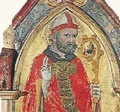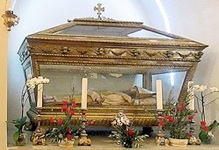


Detail of San Facondino Polyptych (15th century)
Pinacoteca Comunale
The evidence for the cult of St Facundinus and of his deacon, St Juventinus, lies mainly in the ancient church of San Facondino, which was slightly to the north of modern Gualdo Tadino. This church, which was presumably built to house his relics, was destroyed in the tumultuous centuries that followed. [Remains of it have been found at the junction at which the modern Vi Flaminia meets Via delle Cartiere, slightly to the south of the present church.]
This new church was apparently built by Rodolfo and Offredo, the sons of Monaldo III dei Conti di Nocera, who are also credited with the construction of the old Abbazia di San Benedetto. The relics of St Facundinus and Juventinus were duly translated here. One of the gates of the medieval city, which opened onto the road to this church, was named for it.
Francesco Lanzoni (referenced below) and other scholars have suggested that St Facundinus could be the bishop of that name listed by St Athanasius as an attendee of the Synod of Sardica in 342. However, according to a late legend (BHL 2819), he was a bishop of Tadinum who died on 28 August 607. Local tradition relates this to the letter from Pope Gregory I to Bishop Gaudiosus of Gubbio of 599, which instructed him to visit the diocese of Tadinum and to preside over the election of a new bishop.
According to the Legend of St Raynaldus of Nocera, he imitated his predecessor St Facundinus, “a man of exceptional holiness and perfect virtue, who eschewed the comfort of a bed as he prayed in the night, and led a harsh life in the desert”. This follows the tradition recorded in local chronicles that St Facundinus initiated the tradition of eremetical life on “monte Appennino, quod Serra Sanct dicitur” (i.e. Monte Serrasanta). Following the intervention of Bishop Gaudiosus, St Facundinus was duly elected, and served in this post until his death on 28th August 607.
St Facundinus was a patron saint of Gualdo Tadino until 1643, when the Blessed Angelus was chosen as the city’s sole patron.
Relics
A sarcophagus (ca. 7th century) from Santa Colomba, Rimini, which is now in the Cella delle Reliquie of the Tempio Malatestiano, is inscribed:
HEC SVNT NOMINA S[AN]C[T]ORV[M]:
FELICITAS PEREGRINVS FACCONDINVS IVVENTINVS
These are the names of the saints [contained in the sarcophagus]:
Felicita, Peregrine, Facundinus, Gioventinus
and below
HEGO NATALIS PECCATOR EP[ISCOPV]S ANC[ONAE] CORPORA S[AN]C[T]ORUM
This refers to an otherwise unknown Bishop Natale of Ancona
It is possible that this sarcophagus once contained (and perhaps still contains) relics of saints from Gualdo Tadino:
-
✴a church of Santa Felicita outside Gualdo Tadino was documented in the 13th century; and
-
✴the church and village of San Pellegrino, outside Gualdo Tadino, were also documented from about this time.
It is possible that this sarcophagus once contained (and perhaps still contains) relics of saints from Gualdo Tadino:
-
✴a church of Santa Felicita outside Gualdo Tadino was documented in the 13th century; and
-
✴the church and village of San Pellegrino, outside Gualdo Tadino, were also documented from about this time.
However, as noted above, the presumed relics of SS Facundinus and Juventinus have long been venerated in San Facondino. They were formally recognised in 1584 and translated to the new high altar of the church. They were exposed again in 1610 and placed so that they could be seen through a metal grating. Part of the relics were transferred to the Duomo of Nocera at that time. Another recognition was recorded in 1695.

Present reliquary on the left wall of San Facondino
The relics were removed from their wooden reliquary in 1907, on the 3rd centenary of the presumed date of death of St Facundinus, and inserted into the chest of a statue of the saint that was enclosed in a glass sarcophagus on the high altar. When the relics of the Blessed Angelus were placed in a new reliquary and translated to the chapel off the left wall of San Benedetto in 1961, the redundant reliquary (1888) was re-used for the relics of SS Facundinus and Juventinus. I presume that this reliquary, which is now on the left wall of San Facondino, is that of 1888, and that the statue in it still contains the relics of SS Facundinus and Juventinus.
Read more:
F. Lanzoni, “Le Diocesi d'Italia dalle Origini al Principio del Secolo VII”, Faenza (1927) pp 482-3
Return to Saints of Gualdo Tadino.

